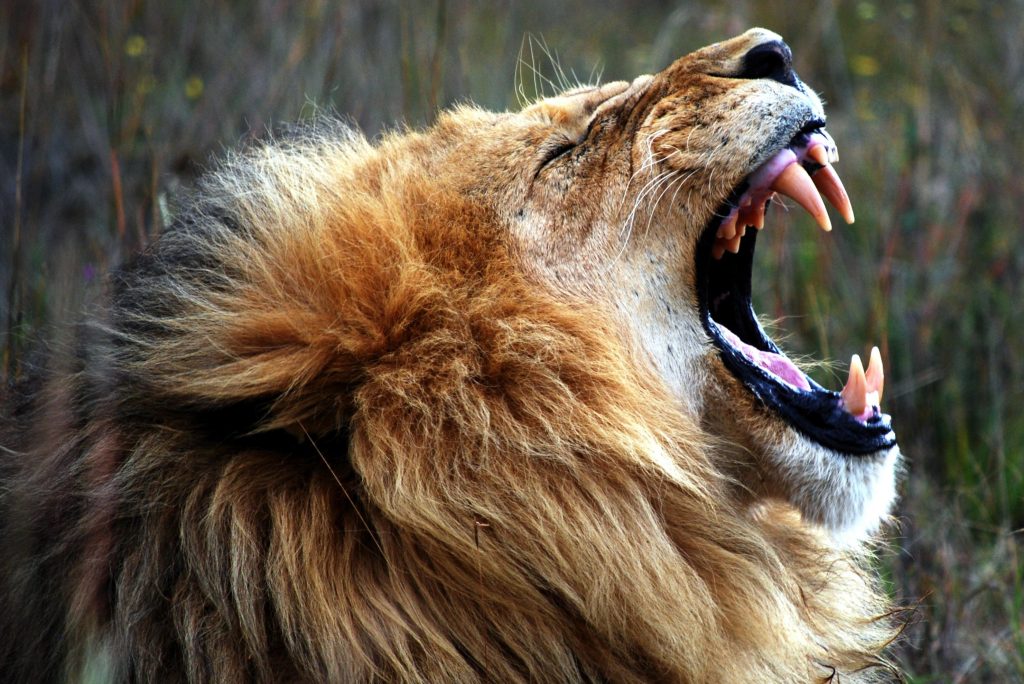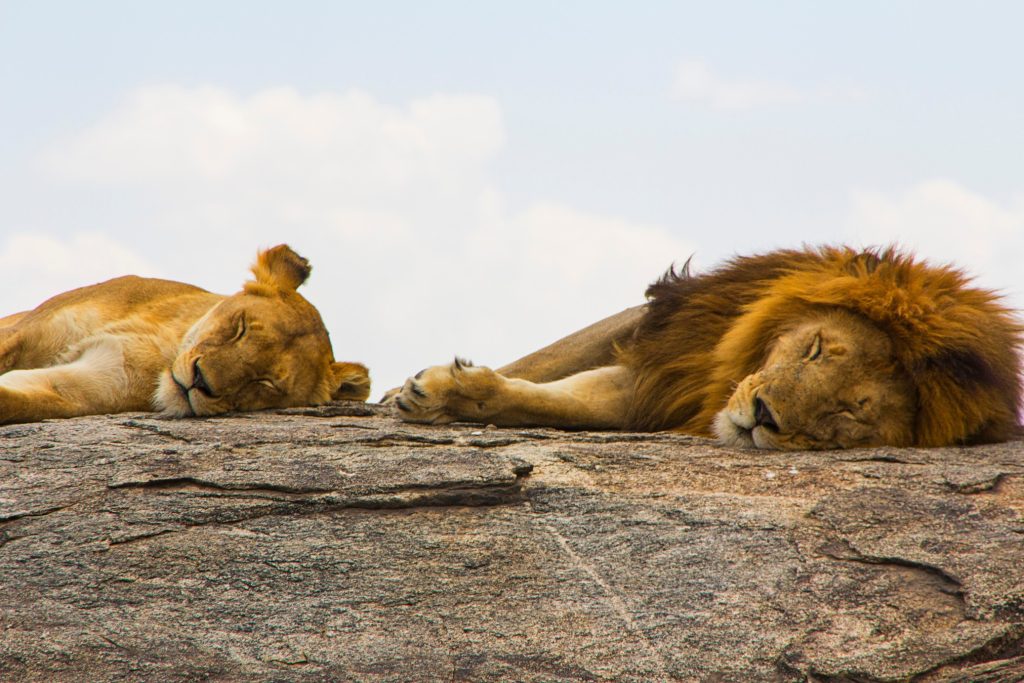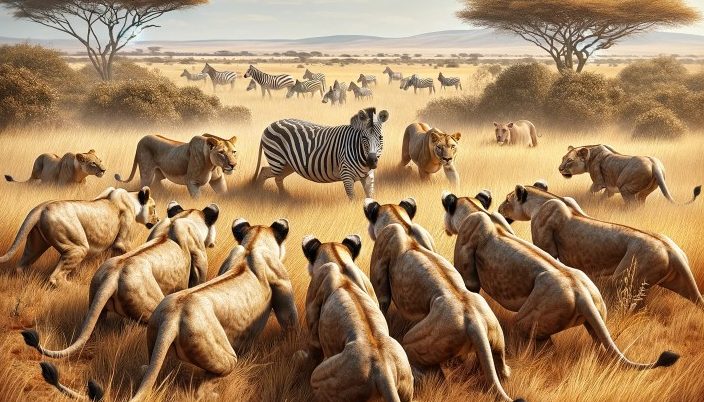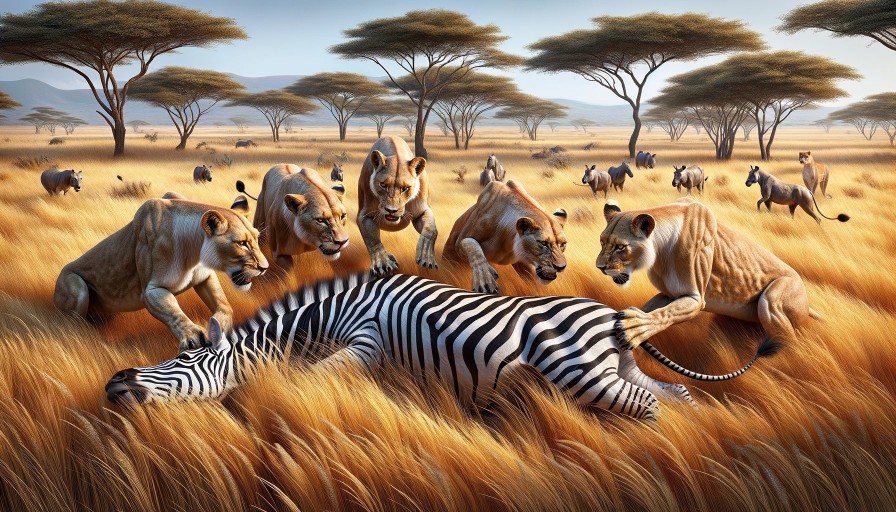In the heart of the African Savannah, where the golden grasses sway gently in the breeze, and the sun casts a warm, amber hue across the landscape, a majestic and formidable creature roams – the Lion. You may have seen them in the zoo near you or perhaps on the TV, but their native habitat remains exclusive to Africa.
Known as the “king of the jungle” & “king of beasts”, and revered for its majestic presence, the lion is more than just an icon of regal power; it is a living testament to the untamed beauty of the natural world.
Since you’re curious about Lions, here are some interesting facts about Lions you probably didn’t know:
The Lion’s Roar is Unimaginably Loud

The lion’s roar is one of the most iconic and impressive sounds in the animal kingdom. A lion’s roar may be heard up to 5 miles away (8 kilometers) and can be nearly as loud as thunder. Lion cubs instinctively vocalize from the moment they enter the world, but it’s not until they reach approximately one year of age that these vocalizations transform into the mighty roars we associate with them. The roar allows lions to assert their territorial ownership, effectively communicating their presence to any potential intruders. It’s like saying “It’s my territory. Don’t dare to step foot on it”. Second, it enables lions to connect and coordinate with their pride members through these distinctive vocal expressions.
Lions are the Only Cats to Live in Social Groups known as “Prides”
Lions are truly unique among the big cat species as they are the only ones to form intricate social groups known as “prides.” A pride typically has one dominant male but may sometimes have 2 to 3 leading males serving as the leaders of the group; and closely related females (sisters) and their offspring. This social structure is a testament to their remarkable ability to cooperate and coordinate, setting them apart from their solitary counterparts in the big cat family. Within the pride, bonds are forged, roles are defined, and a cooperative spirit thrives, making them not only exceptional apex predators but also some of the most socially dynamic creatures in the animal kingdom.
Only Female Lions Hunt for the Pride
In the lion pride, the real hunters are the females. While the mighty males patrol the borders and keep a grip on their territory, it is the female Lions who hunt for their pride, showcasing remarkable agility and tactical prowess during their silent, coordinated hunts. Their success in taking down prey ensures sustenance for the entire pride, including the vulnerable cubs and older members.
Only Male Lions Have Manes
You may or may not be surprised to know that only male lions wear the awe-inspiring mane, which is a distinctive growth of long, thick hair that surrounds the heads, necks, and throats of male lions. It is one of the most recognizable features of these big cats and sets them apart from their female counterparts. The mane is a symbol of strength and dominance that sends shivers down rivals’ spines and melts lionesses’ hearts.
But the mane is more than just a flashy accessory. It serves several crucial purposes in a male lion’s life:
- A Display of Dominance: The mane acts as a visual billboard, sending a clear message to both rivals and potential mates. A darker and fuller mane signifies not only physical strength but also higher levels of testosterone, making the male appear more dominant and attractive. Studies have shown that lionesses prefer males with these impressive manes, increasing their chances of reproductive success.
- A Shield of Protection: The mane is not just for show; it also plays a vital role in protecting the lion during fights. Its thick layers of hair act as a natural armor, cushioning blows and deflecting bites and scratches to the vulnerable neck and throat, which are prime targets during territorial disputes. This extra layer of defense can give the male an edge in combat, increasing his chances of survival and leadership within the pride.
- A Symbol of Status: In the complex social hierarchy of a lion pride, the mane serves as a visible marker of a male’s rank and experience. Older lions with darker, fuller manes typically hold higher positions within the pride, commanding respect and enjoying greater access to resources and mating opportunities. The mane, therefore, is not just a physical attribute but also a social currency, signifying a male’s standing within the group.
Lions Are Mostly Found Only in Africa
Lions, scientifically known as Panthera leo, are predominantly native to the African continent, earning them the common designation of African lions. While these magnificent creatures can be encountered in zoos worldwide, Africa remains their sole indigenous habitat.
Lions once had a widespread global distribution. Approximately 124,000 years ago, several subspecies of lions inhabited various regions around the world. These subspecies included the cave lions of Europe and the American lions of North America. Unfortunately, both of these subspecies became extinct by around 8,000 BC.
The surviving subspecies are the African lions found in sub-Saharan Africa and the Asiatic lions found in India. These remaining populations have faced significant challenges, including poaching, habitat loss, and disease. As of the last available data, it is estimated that around 20,000 African lions exist in the wild, and they are classified as “Vulnerable” by the International Union for Conservation of Nature (IUCN). Asiatic lions, on the other hand, are considered “Endangered” with a population of approximately 500 individuals.
Lions are highly adaptable big cats, thriving in diverse natural landscapes, ranging from open woodlands and dense scrub to grasslands and expansive savannahs. Contrary to the popular image of lions in dense jungles, African lions primarily inhabit the vast open plains of sub-Saharan Africa, where they still exemplify their status as apex predators and symbolize the untamed spirit of the continent.
Lions Don’t Need to Drink Water Everyday They Do Need to Eat!
Yes, you’ve heard it right. Lions can go several days to a week without drinking water. They mostly obtain water by consuming the blood and bodily fluids of their prey, reducing their need for external water sources. They prioritize food over water, allowing them to survive in arid environments. However, their ability to endure without water has limits, and eventually, they will need to drink when the opportunity arises. The exact duration they can go without water can vary based on individual health, environmental factors, and the success of their hunting efforts.
Lions do need to eat regularly, ideally every day or every 2-3 days to retain their energy and stay healthy. In ideal conditions with readily available prey, lions typically hunt and eat every 2-3 days. They consume around 11-15 pounds (5-7 kilograms) of meat per day. Adult female lions need to consume about 11 pounds of meat per day, while adult males eat even more, around 15-16 pounds daily. However, successful hunts aren’t guaranteed. If prey is scarce or they haven’t had a successful kill, lions can adjust their feeding schedule and stretch their meals further.
Lions Are Highly Territorial Creatures
Lions are highly territorial animals, and they fiercely defend their territory against intruding lions from other prides. This territorial behavior is crucial for maintaining access to prey, water sources, and suitable breeding grounds. The size of a lion pride’s territory can vary, but it often encompasses an area ranging from 8 to 155 square miles (20 to 400 square kilometers), depending on factors such as prey availability and habitat quality.
Male lions, in particular, play a key role in patrolling and protecting the pride’s territory, and they will engage in intense battles to maintain their dominance and control over their territory, which they mark with scent markings and vocalizations. This territorial behavior helps ensure the survival and reproductive success of the pride within its defined boundaries. In our future posts, we will talk about some popular lions and lion coalitions, and how they defended their territories against intruding competitors.
Lions Sleep Up to 20 Hours Per Day

You might have heard about Lions being “lazy”, but that’s not entirely true. While it’s true they sleep for a significant portion of their day (around 18-20 hours), this behavior is more due to strategic adaptation than outright laziness. As you know, Lions are ambush predators, and they rely on sudden bursts of intense energy for hunting, not sustained activity. Their long sleep phases conserve energy for these crucial moments of hunting. Sleeping also helps regulate their body temperature, which is especially important in the hot savannas where they live. Also, Lions are light sleepers as they need to be in the wilderness. While snoozing, their senses remain active. They can pick up on subtle sounds and movements of potential prey, making them surprisingly vigilant sleepers. Their sleep behaviour also adapts to their activity levels. When prey is plentiful and hunting conditions are favorable, lions might sleep less. Conversely, during droughts or periods of scarce prey, they may sleep more to conserve energy.
Lions Are Silent Ambush Predators

Lions are not particularly fast runners, only reaching a max speed of up to 50 miles per hour in short burts (meaning they can’t sustain this speed for very long). So they have to rely on stealth/ambush and cooperation to successfully hunt preys. These majestic big cats are well-known for their ability to approach prey quietly, using the cover of tall grass or shrubs to get as close as possible before launching a coordinated attack.
Lionesses divide themselves into flanking groups, encircling the prey to cut off its escape routes and create confusion. Some of them maintain the flanks while others herd the prey towards the ambush using techniques like barking, snarling, and even running alongside the animal. When the prey reaches the ambush zone, the remaining lionesses attack it with incredible speed and power, using their powerful jaws and sharp claws to deliver the final blow. Once the prey is down, the entire pride joins the feast, ensuring all members receive their share of the valuable nutrients. This fosters cohesion within the pride and strengthens their social bonds.

In terms of hunting success, lions are among the most successful of all big cats, with a success rate estimated at around 20-30%. This rate is higher than that of solitary hunters like tigers, which have a lower success rate due to the difficulty of catching prey alone. The cooperative hunting strategy of lions, combined with their ability to ambush silently, makes them highly effective predators in the African savannas.
Lions May Sometimes Be Seen Eating Plants
Lions are primarily carnivorous animals, and their diet consists primarily of meat from the prey they hunt. However, there have been rare observations of lions consuming small amounts of plant matter on occasion. This behavior is thought to serve several purposes:
- Aid in Digestion: Consuming grass or other plants may help lions with their digestion, especially if they have recently consumed a large meal.
- Provide Nutrients: Some plants may provide essential nutrients, fiber, or other elements that complement their diet.
- Act as a Laxative: Plant material can act as a natural laxative, helping to expel indigestible items or parasites from their digestive system.
These instances of plant consumption are relatively infrequent and make up only a small part of a lion’s diet. Lions are primarily obligate carnivores, meaning they rely on animal-based protein for their nutritional needs, and their hunting skills are finely tuned for capturing and consuming prey.
